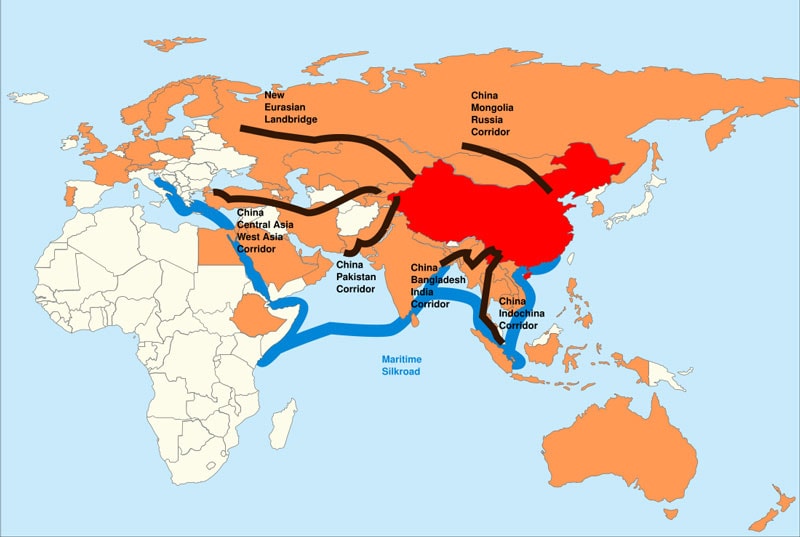The Belt and Road Initiative (BRI), launched by China in 2013, has quickly emerged as one of the most ambitious and transformative international development projects of the 21st century. It seeks to enhance global trade, foster economic growth and improve connectivity through infrastructure development across continents. In its pursuit, the BRI is not only changing the face of global commerce but also fostering cooperation among nations, laying the groundwork for long-term prosperity.
A Vision of Connectivity: At its core, the BRI is about connectivity—both physical and digital—linking Asia with Europe, Africa and even Latin America. The initiative encompasses two primary components: the Silk Road Economic Belt, which is focused on overland routes connecting China to Europe, and the 21st Century Maritime Silk Road, which emphasizes sea routes that link China to Southeast Asia, South Asia, Africa and beyond. This visionary framework aims to re-establish global trade routes that were once the lifeblood of ancient civilizations, facilitating commerce and cultural exchange.
The BRI’s impact on infrastructure development cannot be overstated. Projects funded by the initiative include railways, ports, airports, highways, energy pipelines and telecommunications networks. This large-scale infrastructure investment is designed to foster regional integration, improve access to markets and promote the flow of goods, services and people. For many developing countries, such infrastructure projects are game-changers, enabling them to overcome logistical bottlenecks and expand their economic potential.
Economic Growth and Opportunities: The BRI’s influence on economic growth is evident in the progress seen in numerous countries along the Belt and Road. Through Chinese investment and expertise, countries have been able to build the foundational infrastructure needed to boost productivity and efficiency. For instance, the construction of modern rail networks in countries such as Kenya and Pakistan has significantly reduced transportation costs, enabling businesses to reach new markets and enhance trade volumes.
Moreover, the BRI has provided countries with much-needed capital for large-scale projects. Many of the participating nations, especially those in Africa and Asia, have faced challenges in funding their own development needs. Traditional international financing mechanisms, such as the World Bank and IMF, have often been slow or unable to provide sufficient resources, especially for smaller or landlocked countries. The BRI offers a flexible, alternative funding source, allowing these countries to pursue their development goals without being constrained by the limitations of traditional financing.
In addition to infrastructure, the BRI is catalyzing economic diversification. For example, in Pakistan, the China-Pakistan Economic Corridor (CPEC), a flagship BRI project, has played a central role in developing energy infrastructure and modernizing ports. With long-standing energy shortages, CPEC’s energy projects, such as the development of coal power plants, are helping Pakistan meet its energy demands and drive economic growth. The recent visit of Punjab’s Chief Minister, Maryam Nawaz, to China further highlights the strengthening of economic ties between the two nations. This visit underscores a shared commitment to deepening bilateral relations and exploring new avenues for mutual growth and prosperity.
Promoting Regional Cooperation: One of the most significant aspects of the BRI is its emphasis on regional cooperation and partnership. The initiative fosters collaboration between nations, creating opportunities for bilateral and multilateral cooperation on a scale never before seen. Through trade agreements, joint ventures, and mutual agreements, countries can work together to create shared prosperity. In this respect, the BRI is an example of “win-win” cooperation—benefiting not just China, but the nations that participate in the initiative.
Environmental and Social Responsibility: While the BRI is often associated with infrastructure and economic growth, it is also evolving to include a focus on sustainability and environmental responsibility. In response to concerns about the environmental impact of large-scale projects, China has made a concerted effort to incorporate eco-friendly practices into BRI projects. Many BRI projects now prioritize green energy, such as the development of solar and wind energy projects, which have the potential to reduce the carbon footprint of participating nations.
A Path toward a More Inclusive Global Economy
In today’s world, where economic disparity is often pronounced between developed and developing countries, the BRI offers a new pathway for shared prosperity. By connecting countries and regions that were previously isolated from global trade routes, the BRI is promoting an inclusive global economy where countries at different stages of development can contribute to and benefit from globalization.
The initiative encourages mutual respect and understanding between nations, reducing economic inequality and fostering global peace. As it continues to expand, the BRI has the potential to unlock enormous economic opportunities for countries in Asia, Africa and beyond, contributing to the achievement of global development goals, including poverty reduction, improved living standards and the alleviation of global economic imbalances.
Conclusion
The Belt and Road Initiative is not just about infrastructure or trade; it is a comprehensive strategy for global economic cooperation and development. With its focus on improving connectivity, boosting economic growth, promoting regional cooperation and fostering sustainable development, the BRI is helping to shape the future of the global economy. It provides an innovative framework for tackling some of the most pressing challenges of our time, offering new opportunities for growth and development to countries around the world.
As the BRI continues to evolve, it promises to bring long-term benefits to participating nations, creating a more interconnected and prosperous world. By promoting shared interests, the BRI is not only a driver of economic growth but also a testament to the power of global cooperation. Through this initiative, countries are forging stronger bonds, advancing together toward a brighter and more prosperous future.










